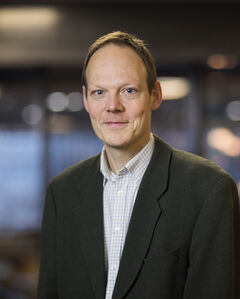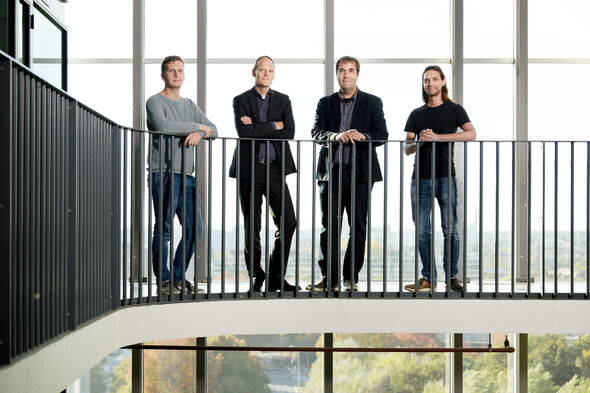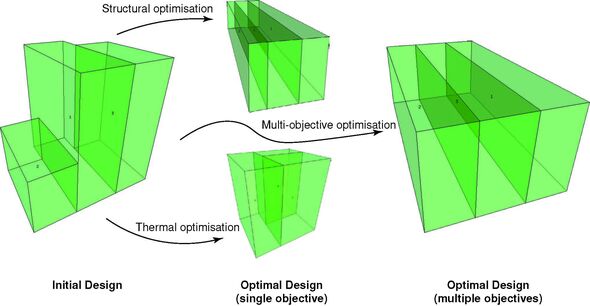The computer as architect
Read more- Research
- 24/10/2018
The computer as architect
The regulations for new buildings are increasingly strict and increasing in number. Obviously, new builds must be safe, but also energy-efficient, divisible into useful spaces and, of course, not too expensive. This makes the design process extremely complex. Thankfully, computer models devised by Hèrm Hofmeyer and his colleagues from Leiden, based on sophisticated algorithms, make the search for optimal designs much easier.
Need a robust building? Then low rise is the cheapest option. But if land is expensive, you'll have to go skywards. And if energy efficiency is your only concern, a spherical building is the solution. In practice it is difficult to satisfy all the conditions imposed on modern buildings, explains Hèrm Hofmeyer. “The set of requirements is ever greater, and every adaptation to the spatial design has consequences for the structure, and vice versa.”

Since the early 1990s, when Hofmeyer graduated from Built Environment, computers have been used in Eindhoven to help design buildings. To prevent accidents, the structure of the building - that part which provides the necessary strength and stability - must always be calculated. And for that math, a computer is just the thing.
Typically, calculations are run not just once. “There's also the spatial design to consider - the collection of rooms and hallways that are built into the structure. As soon as you adapt anything in the spatial design, you have to check whether the structure is still sufficient.” That makes the design of buildings what is known as an iterative process - one in which the various steps have to be repeated again and again until the end result is satisfactory on all fronts.
Evolutionary
Hofmeyer and his colleagues go a step further than simply requiring the computer to do the calculations for a certain configuration that it has been presented with: they allow the computer to search for the best solutions. The computer is given a set of requirements that the final design must satisfy and based on that set it completes, by itself, a number of steps in the design process, explains PhD candidate Sjonnie Boonstra. “We include the indoor climate as a requirement: you should be able to keep the building comfortable without spending too much energy on heating or cooling.”
For Boonstra, making these calculations involves close contact with a fellow PhD candidate at Leiden University, Koen van der Blom, and his supervisor Michael Emmerich. They allow evolutionary algorithms, as they are called, to drive the design process. This mathematical technique borrows from nature and makes use of the arbitrary variation in building designs and their ‘natural’ selection, which similarly drives the evolution of organisms.
Text continues below the picture.
Ping-pong
The number of possible designs remains endless, however, and it is not feasible to run the calculations for all kinds of building forms. “Even if they take only a few seconds of computing time each, a human lifetime wouldn't be enough to calculate them all,” says Boonstra, giving an impression of the size of the problem. “So we use our simulations of design processes, based on construction knowledge, to steer the algorithms, so that the search range stays manageable.”
This involves the PhD candidate in a continuous cycle of message ping-pong with his Leiden counterpart Van der Blom, often by email or telephone. At least once a month they also see each other face to face. Computer scientist Van der Blom explains where there is room for improvement in this automated approach: “Whereas it is immediately obvious to the designer that a building that hovers is impossible, a computer carries out the entire calculation before discovering that it hits a brick wall.”
Good rules
So an algorithm has to include instructions that state in advance when a design is not valid, without excluding any valid designs. That takes quite a bit of careful thought, says Van der Blom: “A simple rule like ‘every room must be connected to the ground’ would, for example, exclude a balcony, which in structural terms isn't problematical. Once a good rule has been conceived, it must be described mathematically, after all a computer doesn't understand our language. Next, the valid designs must be searched through to find the best design in terms of quality.” At this stage, the strategy is to predict which design has the greatest likelihood of performing better than the designs that have been evaluated so far. In this way, as little time as possible is spent on calculating less good designs.
The most difficult step was to optimize for more than one criterion. The computer scientists at Leiden are working on new algorithms for multicriteria optimizations, as these are called. According to Michael Emmerich, this involves examining an abstract space with countless design alternatives, looking for efficient solutions: “These are solutions that you can't improve for a certain criterion without worsening the solution for another criterion. When you apply evolutionary algorithms to this, you can't select only for quality; diversity also becomes essential."
Collapsing stand
The collaboration with Leiden is the highpoint to date in a process lasting decades that has produced various inventions as offshoots over the years, says Hofmeyer. He gives an example: “A graduating student of mine discovered that certain configurations are not stable, and this meant they couldn't be calculated. We simply hadn't built this intelligence into our system. We then worked on this problem together with the graduating student and came up with software to prevent such situations from occurring."
"What's almost unbelievable is that I presented that method in 2011 at a conference at the University of Twente, and a few hours later and just 600 meters away, a stand under construction at FC Twente collapsed causing a fatality. This was later found to be due to a situation that could have been prevented with our method. We have published extensively on our method, but unfortunately it has not yet been taken up commercially.”
Dimensions
If you optimize for various criteria, you get not just one solution but a whole series, explains Boonstra. He points to a curve on a graph in an article published recently by the team. “That is the trade-off front, which represents all designs that satisfy two requirements optimally.” A third requirement produces a curved plane containing solutions: every additional requirement adds a new dimension.
“That is hard to visualize,” says Hofmeyer. “But mathematically it is not fundamentally different. We are also busy simulating the openings in the buildings and we want to move on to more complex geometries and include in them the effect of natural light entering the building. We are discussing this with Evert van Loenen, a professor here at Built Environment who understands this field.”
Automation
This close collaboration with the computer scientists in Leiden is producing a system that supports design processes, says Hofmeyer, and in future it will benefit ordinary people. “We are working with the firm of architects De Twee Snoeken in Den Bosch. They are also heavily involved in automation and have developed a tool that anyone can use to adapt their own new build home to suit their personal wishes: WoonConnect is its name.”
You can use WoonConnect to move an internal wall, he says by way of example. “At present WoonConnect simply calculates the impact of a change on your energy costs, but with our method one can gain real-time advice about the optimal solution. The tool might recommend, for example, that you move the wall in question one more meter in order to achieve the best layout for heating or because it reduces construction costs.”
WoonConnect
“WoonConnect is our online application for digitalizing homes and buildings and for neighborhood innovation,” says Joost van den Buijs, computer scientist at architectural firm and construction software developer De Twee Snoeken. “Municipalities, home owners' associations, housing corporations, real estate developers, as well as home owners, tenants, manufacturers and suppliers are using the tool as part of home renovation projects (sustainability, making the house fit for all phases of a lifetime and comfort) and new build projects.” Occupants are given a digital key and can easily decide for themselves how their home will look. The tool affords an insight into the financing possibilities and available grants, and shows immediately the influence of the choices made on, say, energy costs, rental amount and energy label.
WoonConnect is based on 3D home information models and draws on an extensive library of construction productions named BouwConnect. The models are linked to and from computer-aided design software and work to standards in the construction industry. This collaboration enables De Twee Snoeken to benefit from the fundamental knowledge present at TU/e about the underlying abstract models. In return, TU/e gets to test its theoretical models under the often challenging conditions of the real world.


Discussion